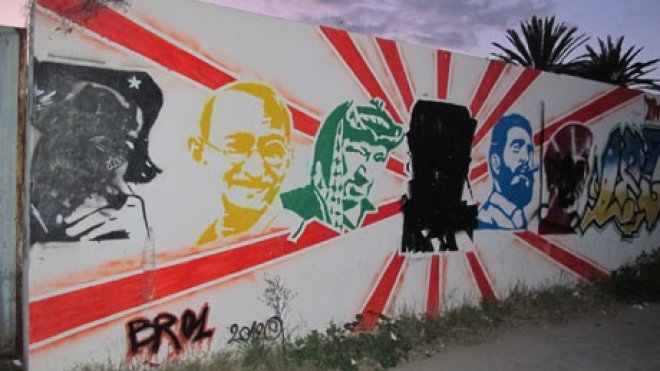Revolutionary Art on the Streets of Tunisia
Assistant Professor Autumn Quezada-Grant examines how Western resistance art has been claimed in Tunisian youth uprising against dictatorial regimes

While in Tunisia last summer for an international course on the democracy and transitional justice arising in Egypt and Tunisia, Assistant Professor of History Autumn Quezada-Grant observed an entirely new form of Tunisian political resistance that bore remarkable similarities to her research interests in Latin-American revolutions.
An expert on post-Castro Cuba and the Zapatistan revolt in Mexico, Quezada-Grant’s work typically involves studying the patterns of Latin-American revolutions to interpret what sparks such a dramatic shift in society and how it plays out.
Imagine her astonishment when she found the faces of Fidel Castro and Ché Guevera among images of masked guerilla fighters – identical in appearance to the crusading Zapatistas – spray-painted on walls throughout the cities of Tunis and Sousse.
Quezada-Grant hadn’t focused on revolutionary art until she observed the images of Latin-American revolutionaries and dictators and other elements of Western culture that had been coopted by young Tunisian radicals to express their discontent following the December 2010 rebellion that gripped the small North African country after a food vendor, Mohamed Bouazizi, lit himself on fire in protest of the government’s oppressive control over its people. Bouazizi’s self-immolation sparked an internationally visible revolt in an otherwise insulated country. The only graffiti previously found in Tunisia were comments about sports teams, Tunisian citizens told Quezada-Grant.
“I said, ‘Why is this here?’ So I started thinking about transnational art, to see how it is that (revolutionary) symbols get reinterpreted by other societies,” she says. “Instead of rejecting the West, they’re embracing it through art and symbols, but reinterpreting it to their specific histories and to match their needs.”
For instance, Quezada-Grant’s analysis draws a connection between the rebelling Tunisians and an enormous mural of Zapatistas from Chiapas, Mexico, painted on a building in Tunisia. Noting that both countries share histories of colonialism (Tunisia was a French colony) and dictatorship, she hypothesizes that Tunisians have embraced images of the Zapatistas because they fought against marginalization, oppression and suppressing the voice of the people.
Still, she abstains from drawing hard-fast conclusions about the Tunisians’ message in their rebellion: “Tunisians are not clear on what they’re angry about,” Quezada-Grant explains. It appears that the rebellion is for economic reasons, and less about promoting radical political change – a protest of the severe food restrictions, pervasive unemployment and lack of social mobility, she says.
A prevalent graffiti slogan in Tunisian cities has been “dégage” – a French word that translates as “to get out” as well as a call for a renaissance, which she says in this case is a call for a rebirth within the Islamist political structure.
As Tunisia’s revolution progressed, access to other societies expanded via the Internet. The youth particularly, as are the young generations of most societies, she says, are drawn to messages depicted through art.
“This generation is so accustomed to music, art, and dance. They communicate through art, be it graffiti art, visual art, music.”
Music, too, has emerged as a form of revolutionary art and expression. According to Quezada-Grant, a Tunisian rapper was recently jailed for referring to the police as “dogs” in a song; and a viral video in Tunisia showed a group doing a synchronized dance in the midst of a street fight with police, as tear gas canisters flew over the dancers’ heads.
“Popular culture is seeping in where it wasn’t before,” she explains, pointing to five decades of dictatorship and colonialism as a cause of insulation. “What I see is it’s really beginning to open people’s minds through popular culture. It’s stimulating them to interpret what they’re going through. But they’re doing it within the confines of Islam – they’re taking in the popular culture but maintaining it within their framework of culture and beliefs.”
Quezada-Grant plans to explore and research this idea further, with another trip to Tunisia this summer to document all the types of graffiti art appearing on the streets. This week she is presenting her preliminary research in a paper titled, “(Re)claiming Expressions: Transnational Latin-American Resistance Art in Tunisia,” at the American Comparative Literature Association in Toronto.
A special library exhibit is now on display in the lobby of the University Library, including photographs of Tunisians protesting in the streets and revolutionary art, as well as an introduction to Tunisian culture via photos and traditional painted ceramics and woven carpets. Quezada-Grant has included information about the Summer School on Democracy and Transitional Justice course at the University of Sousse, and what a young Tunisian scholar and journalist is saying about the opening of freedom of expression in his country. The exhibition is open daily during library hours.
View the slideshow below of the photographs on exhibit and others taken by Quezada-Grant and Emily Masseo, a history and secondary education major who also attended the transitional justice summer course in Sousse, Tunisia: